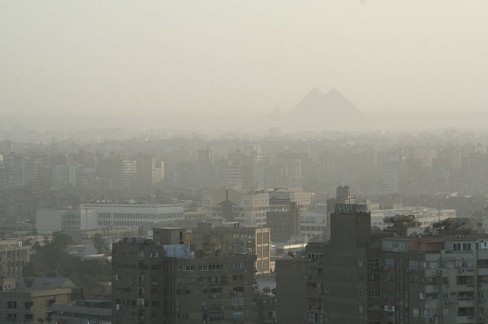In 2012 around 7 million people died as a result of air pollution exposure according to the World Health Organization. Air Pollution is now the world’s largest single environmental health risk. Reducing air pollution could save lives around the globe and our own buildings could be a solution.

The air is a vital part of our environment, which makes air pollution an ever-relevant topic. A typical human inhales 7 to 14 liters of air every minute. One component of pollution is smog. Nitrogen oxides – a product of fuel consumption – react with organic compounds with low boiling points (“volatile organic compounds” or “VOCs”) in the presence of sunlight to create smog. Contrary to popular belief, death as a result of smog is often not a direct result of poisoning by pollutants in the air, but rather, a result increasing susceptibility to diseases.
So where do buildings come in as potential solutions to air pollution? Companies are beginning to sell roof tiles that are coated with a highly versatile chemical known as titanium dioxide. Titanium dioxide is used in areas as diverse as plastics, sunscreens, and food. Titanium dioxide’s intense whiteness makes it very popular in paints, and its other special properties make it the basis for promising new developments in solar cells.
However, the characteristic of titanium dioxide that is crucial in combating pollution is its ability to facilitate chemical reactions when exposed to light. Chemical compounds capable of this are known as phocatalysts. When exposed to ultraviolet light titanium dioxide accelerates many chemical reactions. One of the reactions it can accelerate is the destruction of two of the primary contributors of smog, nitrogen oxides and volatile organic compounds. In the presence of light and oxygen, titanium dioxide transforms harmful nitrogen oxide gas to comparably harmless nitrates. Further, it can transform volatile organic compounds to compounds known as fatty acids, which more readily settle out of the atmosphere.
In one study done on the topic by a team at the University of California Riverside’s Bourns college of Engineering, students calculated that 21 tons of nitrogen oxides would be eliminated daily if one million roofs were coated with their titanium dioxide mixture. The tiles removed between 88 percent and 97 percent of the nitrogen oxides in the experimental chamber.
In a world controlled by money, just how economical is this project? Estimates by the Riverside team predict that it would only cost $5 dollars to coat an already existing roof. Each roof would then be capable of destroying the same amount of nitrogen oxides and volatile organic compounds that a typical car releases driving 11184 miles (18,000km) annually. However cheap these might be to install, there remains no financial incentive for individual homeowners to do so. Perhaps government subsidies in the interest of public health could remedy this situation.
Although these roofs seem like a no-brainer there is still the problem of the contaminated runoff. In an ideal world the titanium dioxide would stay on the roof and the rain would fall off the roof with the ‘clean’ soluble nitrates and fatty acids. These ‘clean’ products can be used as fertilizers and in industrial processes. However, as any house painter will tell you, it is nearly impossible to make a coating that will stand the test of time. Inevitably, tiny particles of titanium dioxide will also wash off these roof tiles and enter the surrounding ecosystem. Some of these particles might even be nano-sized. This provides some further motivation for the work we do here at the Center for Sustainable Nanotechnology—to predict what harm these particles may cause and be able to make particles that are benign by design.
Sadly these Titanium dioxide roofs cannot trap other emissions such as carbon dioxide that require more difficult-to-install roofs. However, I think this approach to smog remediation offers one promising step towards a cleaner earth.


[…] via Sustainable Nano […]
One approach suggested to fight climate change/the urban heat island effect is white rooves that reflect the sun’s energy back out into space. Given that titanium dioxide is often used as a white pigment, would it be possible to combine this with the NOx-removing capability?
Hi Andy! That is an awesome call! I can’t think of any reason that wouldn’t be possible.